HOME
PLANTS
Unusual Trees
There are many types of unusual trees around the world that exhibit a
variety of interesting characteristics. Among these are prehistoric
relics, trees that exhibit bizarre growth patterns or formations, and
trees with interesting strategies for obtaining the air, water, and
nutrients necessary for growth.
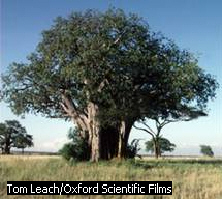 Baobab,
common name for a tropical African tree. The baobab tree grows only
to the height of a large maple tree, but extensive lateral growth
makes it one of the largest trees. The trunk of the baobab sometimes
attains a diameter of 30 feet, and the branches, frequently as thick
as the trunks of other large trees, form a hemispherical mass of
foliage often 150 feet in diameter. The fruit, called monkey bread,
is about the size of a citron; the pulp, which has a pleasing acid
taste, is used in the preparation of cooling drinks. The bark of the
tree yields a strong cordage fiber. The baobab, native to Africa, is
now cultivated in many tropical countries throughout the world.
Baobab,
common name for a tropical African tree. The baobab tree grows only
to the height of a large maple tree, but extensive lateral growth
makes it one of the largest trees. The trunk of the baobab sometimes
attains a diameter of 30 feet, and the branches, frequently as thick
as the trunks of other large trees, form a hemispherical mass of
foliage often 150 feet in diameter. The fruit, called monkey bread,
is about the size of a citron; the pulp, which has a pleasing acid
taste, is used in the preparation of cooling drinks. The bark of the
tree yields a strong cordage fiber. The baobab, native to Africa, is
now cultivated in many tropical countries throughout the world.
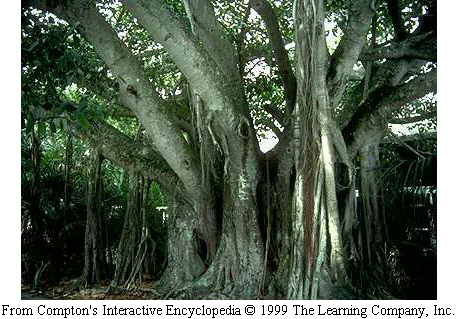 Banyan,
common name for a large Indian tree, remarkable for numerous aerial
roots that, growing down from the branches, take root in the soil and
form prop roots or secondary trunks. In this manner the tree spreads
over a large area. As the tree ages, the original trunk decays, and
the tree breaks up into several sections, the props becoming separate
trunks for the various sections. The banyan is a species of fig, with
heart-shaped leaves about 6 inches long. The fruit is scarlet, about
the size of a cherry, and grows in pairs from the axils of the
leaves. The seeds seldom germinate in the ground, but, deposited by
birds in the crowns of palm trees, germinate there and send down
roots that embrace and eventually kill the palms. A famous banyan in
the Botanical Gardens in Calcutta is more than a century old. The
main trunk is more than 40 feet in circumference; it has 230 prop
roots 6 to 10 feet around, and more than 3000 smaller trunks. Banyan
trees can live to be well over 100 years old.
Banyan,
common name for a large Indian tree, remarkable for numerous aerial
roots that, growing down from the branches, take root in the soil and
form prop roots or secondary trunks. In this manner the tree spreads
over a large area. As the tree ages, the original trunk decays, and
the tree breaks up into several sections, the props becoming separate
trunks for the various sections. The banyan is a species of fig, with
heart-shaped leaves about 6 inches long. The fruit is scarlet, about
the size of a cherry, and grows in pairs from the axils of the
leaves. The seeds seldom germinate in the ground, but, deposited by
birds in the crowns of palm trees, germinate there and send down
roots that embrace and eventually kill the palms. A famous banyan in
the Botanical Gardens in Calcutta is more than a century old. The
main trunk is more than 40 feet in circumference; it has 230 prop
roots 6 to 10 feet around, and more than 3000 smaller trunks. Banyan
trees can live to be well over 100 years old.
 Like
the ginkgo, the dawn redwood is old enough to be considered a
living fossil. Its fossilized remains were studied and identified in
the 1800s, and scientists believed that the tree had become extinct
about 20 million years ago. In 1941, however, a Chinese botanist
discovered living trees in an isolated valley in central China. Since
then, the tree has been found in other places in China, and the
fossil record indicates that millions of years ago it grew in
Greenland and in North America as far south as California. Like other
sequoias, the dawn redwood grows well from seeds, and seedlings have
been planted throughout the Pacific Northwest and in Alaska. Specimen
trees have also been successfully grown in many of the milder parts
of the East Coast of the United States. Unlike other sequoias, the
dawn redwood is deciduous and loses its leaves in the fall. The dawn
redwood is considered to be ancestral to the coast redwood and giant
sequoia. Young dawn redwoods such as this specimen are now cultivated
throughout the world.
Like
the ginkgo, the dawn redwood is old enough to be considered a
living fossil. Its fossilized remains were studied and identified in
the 1800s, and scientists believed that the tree had become extinct
about 20 million years ago. In 1941, however, a Chinese botanist
discovered living trees in an isolated valley in central China. Since
then, the tree has been found in other places in China, and the
fossil record indicates that millions of years ago it grew in
Greenland and in North America as far south as California. Like other
sequoias, the dawn redwood grows well from seeds, and seedlings have
been planted throughout the Pacific Northwest and in Alaska. Specimen
trees have also been successfully grown in many of the milder parts
of the East Coast of the United States. Unlike other sequoias, the
dawn redwood is deciduous and loses its leaves in the fall. The dawn
redwood is considered to be ancestral to the coast redwood and giant
sequoia. Young dawn redwoods such as this specimen are now cultivated
throughout the world.
 Great
Basin bristlecone pine can live over 4000 years and is
believed to be one of the oldest living trees on the planet. All
members of the pine family have needlelike leaves, generally longer
than those of other conifers, which appear in clusters of two to
five, depending on the species. Pines are extremely adaptable to a
range of climatic and soil conditions and are widespread in their
distribution.
Great
Basin bristlecone pine can live over 4000 years and is
believed to be one of the oldest living trees on the planet. All
members of the pine family have needlelike leaves, generally longer
than those of other conifers, which appear in clusters of two to
five, depending on the species. Pines are extremely adaptable to a
range of climatic and soil conditions and are widespread in their
distribution. 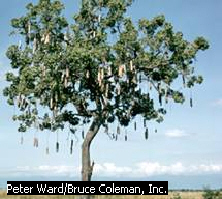
Although it is native to Africa, the sausage tree is
cultivated as an ornamental in warm areas such as southern Florida
and Hawaii. The sausage tree has large deep red flowers, which are
replaced eventually by giant sausage-shaped fruits or woody capsules
about 24 inches long, 4 inches wide, and weigh up to 12 pounds. The
fruit takes a year to ripen and is inedible, but is often used in
folk remedies for skin conditions.
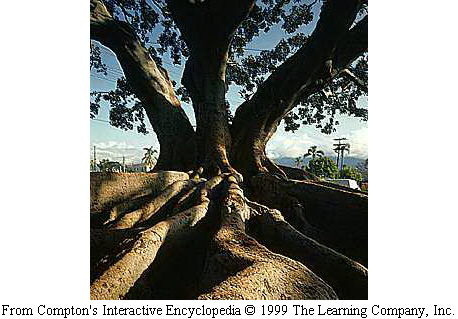 Mission
fig trees, (left) with roots that grow above ground, can reach
50 feet in height.
Mission
fig trees, (left) with roots that grow above ground, can reach
50 feet in height.
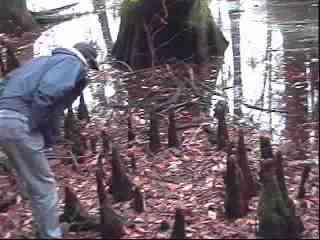

Bald cypress trees are needle-leaf trees that grow in swampy
areas. These organs are extensions from the root system that project
above the usual water level and absorb oxygen from the air for use by
the roots. It grows very large, and it may live more than 12
centuries. Some specimens are 150 feet tall with a limb spread of 80
feet. In swamps the roots spread out for support. Some of the roots
send knobby "knees" up above the water to get air. The tree
is called "bald" because, though a conifer, it sheds its
leaves in the fall.
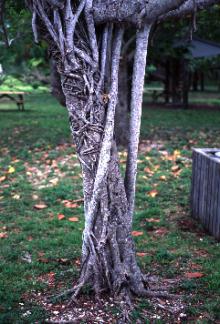 Strangler
fig trees are an example of a parasitic method of development
that occurs in several plant families. A seed is deposited by a bird,
monkey, or other animal in a depression or a crotch of a limb. The
seed sprouts and begins to develop, and roots eventually find their
way to the ground, sometimes traveling 25 m (82 ft) or more. There
the roots take hold and begin to enlarge toward each other, enclosing
the trunk of the host tree. Finally, the roots join side by side to
restrict the growth of the original tree, which eventually rots away,
leaving the parasite standing as an independent plant.
Strangler
fig trees are an example of a parasitic method of development
that occurs in several plant families. A seed is deposited by a bird,
monkey, or other animal in a depression or a crotch of a limb. The
seed sprouts and begins to develop, and roots eventually find their
way to the ground, sometimes traveling 25 m (82 ft) or more. There
the roots take hold and begin to enlarge toward each other, enclosing
the trunk of the host tree. Finally, the roots join side by side to
restrict the growth of the original tree, which eventually rots away,
leaving the parasite standing as an independent plant.
Sources:
"Tree," Microsoft® Encarta® Encyclopedia 99. ©
1993-1998 Microsoft Corporation. All rights reserved.
"Tree," Compton's Interactive Encyclopedia © 1999 The
Learning Company, Inc.
 Baobab,
common name for a tropical African tree. The baobab tree grows only
to the height of a large maple tree, but extensive lateral growth
makes it one of the largest trees. The trunk of the baobab sometimes
attains a diameter of 30 feet, and the branches, frequently as thick
as the trunks of other large trees, form a hemispherical mass of
foliage often 150 feet in diameter. The fruit, called monkey bread,
is about the size of a citron; the pulp, which has a pleasing acid
taste, is used in the preparation of cooling drinks. The bark of the
tree yields a strong cordage fiber. The baobab, native to Africa, is
now cultivated in many tropical countries throughout the world.
Baobab,
common name for a tropical African tree. The baobab tree grows only
to the height of a large maple tree, but extensive lateral growth
makes it one of the largest trees. The trunk of the baobab sometimes
attains a diameter of 30 feet, and the branches, frequently as thick
as the trunks of other large trees, form a hemispherical mass of
foliage often 150 feet in diameter. The fruit, called monkey bread,
is about the size of a citron; the pulp, which has a pleasing acid
taste, is used in the preparation of cooling drinks. The bark of the
tree yields a strong cordage fiber. The baobab, native to Africa, is
now cultivated in many tropical countries throughout the world. Banyan,
common name for a large Indian tree, remarkable for numerous aerial
roots that, growing down from the branches, take root in the soil and
form prop roots or secondary trunks. In this manner the tree spreads
over a large area. As the tree ages, the original trunk decays, and
the tree breaks up into several sections, the props becoming separate
trunks for the various sections. The banyan is a species of fig, with
heart-shaped leaves about 6 inches long. The fruit is scarlet, about
the size of a cherry, and grows in pairs from the axils of the
leaves. The seeds seldom germinate in the ground, but, deposited by
birds in the crowns of palm trees, germinate there and send down
roots that embrace and eventually kill the palms. A famous banyan in
the Botanical Gardens in Calcutta is more than a century old. The
main trunk is more than 40 feet in circumference; it has 230 prop
roots 6 to 10 feet around, and more than 3000 smaller trunks. Banyan
trees can live to be well over 100 years old.
Banyan,
common name for a large Indian tree, remarkable for numerous aerial
roots that, growing down from the branches, take root in the soil and
form prop roots or secondary trunks. In this manner the tree spreads
over a large area. As the tree ages, the original trunk decays, and
the tree breaks up into several sections, the props becoming separate
trunks for the various sections. The banyan is a species of fig, with
heart-shaped leaves about 6 inches long. The fruit is scarlet, about
the size of a cherry, and grows in pairs from the axils of the
leaves. The seeds seldom germinate in the ground, but, deposited by
birds in the crowns of palm trees, germinate there and send down
roots that embrace and eventually kill the palms. A famous banyan in
the Botanical Gardens in Calcutta is more than a century old. The
main trunk is more than 40 feet in circumference; it has 230 prop
roots 6 to 10 feet around, and more than 3000 smaller trunks. Banyan
trees can live to be well over 100 years old. Like
the ginkgo, the dawn redwood is old enough to be considered a
living fossil. Its fossilized remains were studied and identified in
the 1800s, and scientists believed that the tree had become extinct
about 20 million years ago. In 1941, however, a Chinese botanist
discovered living trees in an isolated valley in central China. Since
then, the tree has been found in other places in China, and the
fossil record indicates that millions of years ago it grew in
Greenland and in North America as far south as California. Like other
sequoias, the dawn redwood grows well from seeds, and seedlings have
been planted throughout the Pacific Northwest and in Alaska. Specimen
trees have also been successfully grown in many of the milder parts
of the East Coast of the United States. Unlike other sequoias, the
dawn redwood is deciduous and loses its leaves in the fall. The dawn
redwood is considered to be ancestral to the coast redwood and giant
sequoia. Young dawn redwoods such as this specimen are now cultivated
throughout the world.
Like
the ginkgo, the dawn redwood is old enough to be considered a
living fossil. Its fossilized remains were studied and identified in
the 1800s, and scientists believed that the tree had become extinct
about 20 million years ago. In 1941, however, a Chinese botanist
discovered living trees in an isolated valley in central China. Since
then, the tree has been found in other places in China, and the
fossil record indicates that millions of years ago it grew in
Greenland and in North America as far south as California. Like other
sequoias, the dawn redwood grows well from seeds, and seedlings have
been planted throughout the Pacific Northwest and in Alaska. Specimen
trees have also been successfully grown in many of the milder parts
of the East Coast of the United States. Unlike other sequoias, the
dawn redwood is deciduous and loses its leaves in the fall. The dawn
redwood is considered to be ancestral to the coast redwood and giant
sequoia. Young dawn redwoods such as this specimen are now cultivated
throughout the world. Great
Basin bristlecone pine can live over 4000 years and is
believed to be one of the oldest living trees on the planet. All
members of the pine family have needlelike leaves, generally longer
than those of other conifers, which appear in clusters of two to
five, depending on the species. Pines are extremely adaptable to a
range of climatic and soil conditions and are widespread in their
distribution.
Great
Basin bristlecone pine can live over 4000 years and is
believed to be one of the oldest living trees on the planet. All
members of the pine family have needlelike leaves, generally longer
than those of other conifers, which appear in clusters of two to
five, depending on the species. Pines are extremely adaptable to a
range of climatic and soil conditions and are widespread in their
distribution. 
 Mission
fig trees, (left) with roots that grow above ground, can reach
50 feet in height.
Mission
fig trees, (left) with roots that grow above ground, can reach
50 feet in height.

 Strangler
fig trees are an example of a parasitic method of development
that occurs in several plant families. A seed is deposited by a bird,
monkey, or other animal in a depression or a crotch of a limb. The
seed sprouts and begins to develop, and roots eventually find their
way to the ground, sometimes traveling 25 m (82 ft) or more. There
the roots take hold and begin to enlarge toward each other, enclosing
the trunk of the host tree. Finally, the roots join side by side to
restrict the growth of the original tree, which eventually rots away,
leaving the parasite standing as an independent plant.
Strangler
fig trees are an example of a parasitic method of development
that occurs in several plant families. A seed is deposited by a bird,
monkey, or other animal in a depression or a crotch of a limb. The
seed sprouts and begins to develop, and roots eventually find their
way to the ground, sometimes traveling 25 m (82 ft) or more. There
the roots take hold and begin to enlarge toward each other, enclosing
the trunk of the host tree. Finally, the roots join side by side to
restrict the growth of the original tree, which eventually rots away,
leaving the parasite standing as an independent plant.